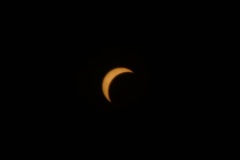Who else witnessed the partial solar eclipse? It was a truly breathtaking experience!
As the moon partially covered the sun (here in Florida, we only got to see it partially), the world dimmed in an otherworldly way, we could feel the air cooling, and there was a lot of aww and ohh.
It was a unique experience, and it made me wonder why we architects get especially excited about such an event.
Well, for once, it served as a powerful reminder of the immense scale of the universe and our place within it.
But beyond the spectacle, this astronomical event has interesting connections to the world of architecture. After all, we architects design structures that interact with sunlight, and strive to make the best use of the effects of the natural world through design Here are a few thoughts:
Solar Path:
Understanding the path of the sun throughout the year is crucial for architects. Simulating solar movement can help us design buildings that optimize natural light intake while minimizing unwanted heat gain. We don’t plan for solar eclipses, but they serve as a powerful reminder of the sun’s impact on our environment.
Shadow Studies:
The way light and shadow interact with our environment is a core architectural principle. Studying how shadows shift during an eclipse can provide valuable insights for designing facades and building elements that create dynamic and visually intriguing effects.
Biophilic Design:
Architects strive to create buildings that connect occupants with nature. Witnessing a celestial event like an eclipse firsthand can rekindle our appreciation for the natural world and inspire biophilic design elements that integrate with the sky and sunlight.
Climate change:
The high cost of energy, coupled with reducing dependence on non-renewable energy sources, is important to architects. Utilizing design strategies to reduce heat loss and heat gain allows for a reduced environmental footprint and a lower operational cost for the constructed building.
The partial eclipse was a fascinating display of cosmic mechanics, but it also offered valuable lessons for those who design our built environment. It’s a call to embrace natural light while mitigating its harsh effects. It’s about creating buildings that are not only functional but also responsive to the external environment, fostering a connection with the natural world.









